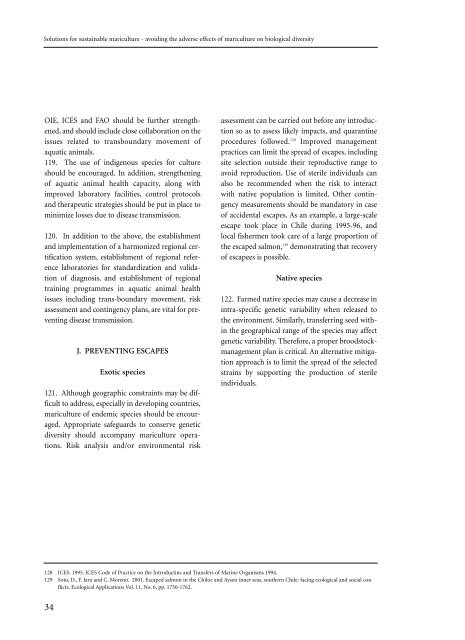Solutions for sustainable mariculture - Convention on Biological ...
Solutions for sustainable mariculture - Convention on Biological ...
Solutions for sustainable mariculture - Convention on Biological ...
- No tags were found...
Create successful ePaper yourself
Turn your PDF publications into a flip-book with our unique Google optimized e-Paper software.
<str<strong>on</strong>g>Soluti<strong>on</strong>s</str<strong>on</strong>g> <str<strong>on</strong>g>for</str<strong>on</strong>g> <str<strong>on</strong>g>sustainable</str<strong>on</strong>g> <str<strong>on</strong>g>mariculture</str<strong>on</strong>g> - avoiding the adverse effects of <str<strong>on</strong>g>mariculture</str<strong>on</strong>g> <strong>on</strong> biological diversityOIE, ICES and FAO should be further strengthened,and should include close collaborati<strong>on</strong> <strong>on</strong> theissues related to transboundary movement ofaquatic animals.119. The use of indigenous species <str<strong>on</strong>g>for</str<strong>on</strong>g> cultureshould be encouraged. In additi<strong>on</strong>, strengtheningof aquatic animal health capacity, al<strong>on</strong>g withimproved laboratory facilities, c<strong>on</strong>trol protocolsand therapeutic strategies should be put in place tominimize losses due to disease transmissi<strong>on</strong>.120. In additi<strong>on</strong> to the above, the establishmentand implementati<strong>on</strong> of a harm<strong>on</strong>ized regi<strong>on</strong>al certificati<strong>on</strong>system, establishment of regi<strong>on</strong>al referencelaboratories <str<strong>on</strong>g>for</str<strong>on</strong>g> standardizati<strong>on</strong> and validati<strong>on</strong>of diagnosis, and establishment of regi<strong>on</strong>altraining programmes in aquatic animal healthissues including trans-boundary movement, riskassessment and c<strong>on</strong>tingency plans, are vital <str<strong>on</strong>g>for</str<strong>on</strong>g> preventingdisease transmissi<strong>on</strong>.J. PREVENTING ESCAPESExotic species121. Although geographic c<strong>on</strong>straints may be difficultto address, especially in developing countries,<str<strong>on</strong>g>mariculture</str<strong>on</strong>g> of endemic species should be encouraged.Appropriate safeguards to c<strong>on</strong>serve geneticdiversity should accompany <str<strong>on</strong>g>mariculture</str<strong>on</strong>g> operati<strong>on</strong>s.Risk analysis and/or envir<strong>on</strong>mental riskassessment can be carried out be<str<strong>on</strong>g>for</str<strong>on</strong>g>e any introducti<strong>on</strong>so as to assess likely impacts, and quarantineprocedures followed. 128 Improved managementpractices can limit the spread of escapes, includingsite selecti<strong>on</strong> outside their reproductive range toavoid reproducti<strong>on</strong>. Use of sterile individuals canalso be recommended when the risk to interactwith native populati<strong>on</strong> is limited. Other c<strong>on</strong>tingencymeasurements should be mandatory in caseof accidental escapes. As an example, a large-scaleescape took place in Chile during 1995-96, andlocal fishermen took care of a large proporti<strong>on</strong> ofthe escaped salm<strong>on</strong>, 129 dem<strong>on</strong>strating that recoveryof escapees is possible.Native species122. Farmed native species may cause a decrease inintra-specific genetic variability when released tothe envir<strong>on</strong>ment. Similarly, transferring seed withinthe geographical range of the species may affectgenetic variability. There<str<strong>on</strong>g>for</str<strong>on</strong>g>e, a proper broodstockmanagementplan is critical. An alternative mitigati<strong>on</strong>approach is to limit the spread of the selectedstrains by supporting the producti<strong>on</strong> of sterileindividuals.128 ICES. 1995. ICES Code of Practice <strong>on</strong> the Introductins and Transfers of Marine Organisms 1994.129 Soto, D., F. Jara and C. Moreno. 2001. Escaped salm<strong>on</strong> in the Chiloe and Aysen inner seas, southern Chile: facing ecological and social c<strong>on</strong>flicts. Ecological Applicati<strong>on</strong>s Vol. 11, No. 6, pp. 1750-1762.34
















